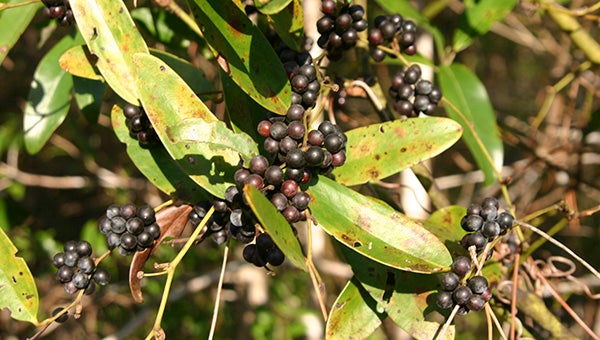Incorporate wild plants into gardening techniques
Published 7:00 am Wednesday, December 28, 2016

Native smilax vine, commonly known as greenbriar or catbrier, produces fruit that has a high value to local wildlife (Photo by Pat Drackett)
By Patricia R.Drackett
Pat is the director of the Crosby Arboreteum and assistant extension professor of landscape architecture with the Mississippi State University Extension Service.
How well are you acquainted with the “wild” plants growing on your property? If you have a patch, or forest, composed of native species, and can’t pin a name on any of the plants you see here, visit the Crosby Arboretum for resources to help identify and learn more about natural landscapes.
Why not make it a New Year’s resolution to learn more about Mississippi’s native plants. Or, consider doing something simple with a big payoff – plant a tree! Perhaps you have a friend or family you would like to honor with such a gesture.
I remember a cluster of live oaks that once made an impression a long while back, while visiting some potential clients during my former career as a landscape designer. As we walked their property, they pointed out a grove of trees, and remarked that as each of their children was born, they had planted a tree to honor their birth. As the years passed, the children enjoyed visiting “their tree”, and the family would hold celebrations in the family “forest”.
There is something quite awesome about the process of watching a tree grow up. However, many people believe that trees, especially live oaks, are very slow-growing, but they can actually grow quite quickly when given the proper conditions.
The coming winter months will bring excellent weather for planting projects, and there are many outstanding native trees to choose from. Visit the MSU Extension Service website for outstanding publications on Mississippi’s native plants at http://extension.msstate.edu/. These resources will help you select the appropriate trees and shrubs to plant based on your needs and your property’s environmental conditions.
When planting a tree, consider its purpose. Do you need to screen an unsightly view, or create privacy? Research evergreen species such as southern magnolia, sweetbay magnolia, or American holly. Are you looking for shade? If you have room, the broad, spreading crown of a live oak can fill this need.
How about a show-stopping flowering tree? Southern crabapple certainly fits that bill. The beautiful pink blooms make it highly desirable for a garden accent. In the “old days” its fruit was often made into jelly, and some dedicated people still carry on this tradition.
Another popular native fruit tree is the mayhaw. This tree, which is in the Rose family, produces a tart red fruit in May and has delicate white spring blossoms. If you look closely at the blooms, you will see that they resemble blackberry or dewberry blossoms, which are in the same family.
Visitors will find that, like the Arboretum’s activities, a walk down our pathways will also provide a vastly different experience from one week to the next. We have over three miles of trails to explore at our public garden. These allow visitors the Arboretum the opportunity to walk among native plants in their natural habitats.
The plants featured at the Arboretum are native to the Pearl River Drainage Basin of Mississippi and Louisiana, in three distinct exhibits – Woodland, Savanna, and Aquatic. Come learn about winter botany on a field walk with MSU Extension Forestry specialist Dr. Glenn Hughes on Saturday, February 4!
See the winter gallery exhibit of Pearl River Paintings by Carriere artist Jeanie Latiolais, on display through the end of February. Mark your calendar for a Pine Needle Basket Workshop on Saturday, January 14 with Stone County Extension Agent Dr. Judy Breland.
Learn how to “Prepare Your Garden for Spring” with Pearl River County Extension Agent Dr. Eddie Smith on Saturday, January 21. For winter planting projects before hot weather returns, come to our Arbor Day native plant sale on Saturday, February 18.
For more information on our activities and events, see our winter schedule on the website at www.crosbyarboretum.msstate.edu
Our annual Forge Day will return on Saturday, January 28. Join us for an exciting day of demonstrations by area metalworkers and craftsmen. Members free. Non-members pay site admission, $5 for adults, and $2 for children.
The Arboretum is located in Picayune, off I-59 Exit 4, at 370 Ridge Road.





